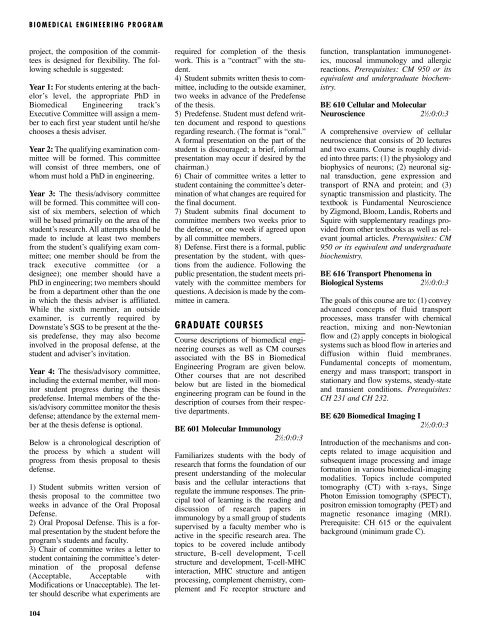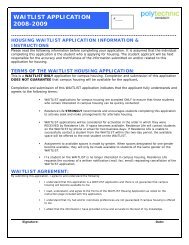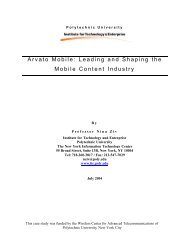POLYTECHNIC UNIVERSITY 2005-2007
POLYTECHNIC UNIVERSITY 2005-2007
POLYTECHNIC UNIVERSITY 2005-2007
You also want an ePaper? Increase the reach of your titles
YUMPU automatically turns print PDFs into web optimized ePapers that Google loves.
BIOMEDICAL ENGINEERING PROGRAM<br />
project, the composition of the committees<br />
is designed for flexibility. The following<br />
schedule is suggested:<br />
Year 1: For students entering at the bachelor’s<br />
level, the appropriate PhD in<br />
Biomedical Engineering track’s<br />
Executive Committee will assign a member<br />
to each first year student until he/she<br />
chooses a thesis adviser.<br />
Year 2: The qualifying examination committee<br />
will be formed. This committee<br />
will consist of three members, one of<br />
whom must hold a PhD in engineering.<br />
Year 3: The thesis/advisory committee<br />
will be formed. This committee will consist<br />
of six members, selection of which<br />
will be based primarily on the area of the<br />
student’s research. All attempts should be<br />
made to include at least two members<br />
from the student’s qualifying exam committee;<br />
one member should be from the<br />
track executive committee (or a<br />
designee); one member should have a<br />
PhD in engineering; two members should<br />
be from a department other than the one<br />
in which the thesis adviser is affiliated.<br />
While the sixth member, an outside<br />
examiner, is currently required by<br />
Downstate’s SGS to be present at the thesis<br />
predefense, they may also become<br />
involved in the proposal defense, at the<br />
student and adviser’s invitation.<br />
Year 4: The thesis/advisory committee,<br />
including the external member, will monitor<br />
student progress during the thesis<br />
predefense. Internal members of the thesis/advisory<br />
committee monitor the thesis<br />
defense; attendance by the external member<br />
at the thesis defense is optional.<br />
Below is a chronological description of<br />
the process by which a student will<br />
progress from thesis proposal to thesis<br />
defense.<br />
1) Student submits written version of<br />
thesis proposal to the committee two<br />
weeks in advance of the Oral Proposal<br />
Defense.<br />
2) Oral Proposal Defense. This is a formal<br />
presentation by the student before the<br />
program’s students and faculty.<br />
3) Chair of committee writes a letter to<br />
student containing the committee’s determination<br />
of the proposal defense<br />
(Acceptable, Acceptable with<br />
Modifications or Unacceptable). The letter<br />
should describe what experiments are<br />
104<br />
required for completion of the thesis<br />
work. This is a “contract” with the student.<br />
4) Student submits written thesis to committee,<br />
including to the outside examiner,<br />
two weeks in advance of the Predefense<br />
of the thesis.<br />
5) Predefense. Student must defend written<br />
document and respond to questions<br />
regarding research. (The format is “oral.”<br />
A formal presentation on the part of the<br />
student is discouraged; a brief, informal<br />
presentation may occur if desired by the<br />
chairman.)<br />
6) Chair of committee writes a letter to<br />
student containing the committee’s determination<br />
of what changes are required for<br />
the final document.<br />
7) Student submits final document to<br />
committee members two weeks prior to<br />
the defense, or one week if agreed upon<br />
by all committee members.<br />
8) Defense. First there is a formal, public<br />
presentation by the student, with questions<br />
from the audience. Following the<br />
public presentation, the student meets privately<br />
with the committee members for<br />
questions. A decision is made by the committee<br />
in camera.<br />
GRADUATE COURSES<br />
Course descriptions of biomedical engineering<br />
courses as well as CM courses<br />
associated with the BS in Biomedical<br />
Engineering Program are given below.<br />
Other courses that are not described<br />
below but are listed in the biomedical<br />
engineering program can be found in the<br />
description of courses from their respective<br />
departments.<br />
BE 601 Molecular Immunology<br />
2 1 ⁄2:0:0:3<br />
Familiarizes students with the body of<br />
research that forms the foundation of our<br />
present understanding of the molecular<br />
basis and the cellular interactions that<br />
regulate the immune responses. The principal<br />
tool of learning is the reading and<br />
discussion of research papers in<br />
immunology by a small group of students<br />
supervised by a faculty member who is<br />
active in the specific research area. The<br />
topics to be covered include antibody<br />
structure, B-cell development, T-cell<br />
structure and development, T-cell-MHC<br />
interaction, MHC structure and antigen<br />
processing, complement chemistry, complement<br />
and Fc receptor structure and<br />
function, transplantation immunogenetics,<br />
mucosal immunology and allergic<br />
reactions. Prerequisites: CM 950 or its<br />
equivalent and undergraduate biochemistry.<br />
BE 610 Cellular and Molecular<br />
Neuroscience 2 1 ⁄2:0:0:3<br />
A comprehensive overview of cellular<br />
neuroscience that consists of 20 lectures<br />
and two exams. Course is roughly divided<br />
into three parts: (1) the physiology and<br />
biophysics of neurons; (2) neuronal signal<br />
transduction, gene expression and<br />
transport of RNA and protein; and (3)<br />
synaptic transmission and plasticity. The<br />
textbook is Fundamental Neuroscience<br />
by Zigmond, Bloom, Landis, Roberts and<br />
Squire with supplementary readings provided<br />
from other textbooks as well as relevant<br />
journal articles. Prerequisites: CM<br />
950 or its equivalent and undergraduate<br />
biochemistry.<br />
BE 616 Transport Phenomena in<br />
Biological Systems 2 1 ⁄2:0:0:3<br />
The goals of this course are to: (1) convey<br />
advanced concepts of fluid transport<br />
processes, mass transfer with chemical<br />
reaction, mixing and non-Newtonian<br />
flow and (2) apply concepts in biological<br />
systems such as blood flow in arteries and<br />
diffusion within fluid membranes.<br />
Fundamental concepts of momentum,<br />
energy and mass transport; transport in<br />
stationary and flow systems, steady-state<br />
and transient conditions. Prerequisites:<br />
CH 231 and CH 232.<br />
BE 620 Biomedical Imaging I<br />
2 1 ⁄2:0:0:3<br />
Introduction of the mechanisms and concepts<br />
related to image acquisition and<br />
subsequent image processing and image<br />
formation in various biomedical-imaging<br />
modalities. Topics include computed<br />
tomography (CT) with x-rays, Singe<br />
Photon Emission tomography (SPECT),<br />
positron emission tomography (PET) and<br />
magnetic resonance imaging (MRI).<br />
Prerequisite: CH 615 or the equivalent<br />
background (minimum grade C).




